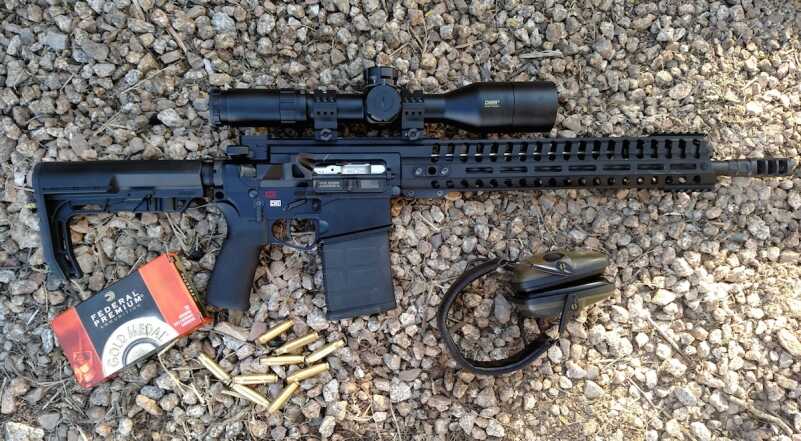
The Revolution .308 AR from POF-USA takes the .308 Win. cartridge and fits it into a gun practically the size of a 5.56mm AR-15.
For more information, visit https://pof-usa.com/revolution/.
To purchase a POF-USA AR on GunsAmerica.com, click this link: https://www.gunsamerica.com/Search.htm?T=POF<id-all=1&as=730&cid=4&ns=0&numberperpage=50&.
The AR platform has become the standard design for modern sporting and defense rifles in the U.S. as well as much of the rest of the world. The gun offers exceptional modularity and is found in the hands of everyone from Delta (CAG) operators to hunters stalking deer in the backwoods. The term “AR” is often incorrectly defined as “assault rifle,” when in fact it is a reference to the original manufacturer of the gun, Armalite. What is a surprise to many is that the original design in this platform was not the AR-15 we see so much today, but was, in fact, a .308 rifle designated as the Armalite AR-10.
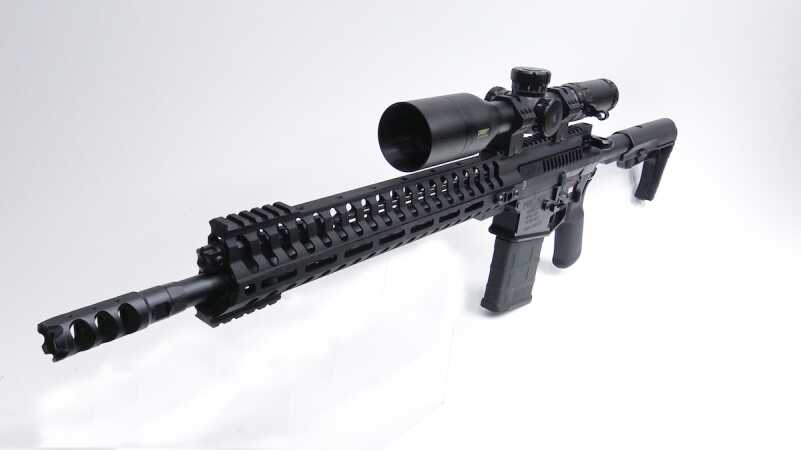
The Revolution weighs in at 7.3 pounds, while still delivering .308 Win. firepower. Shown equipped with Bushnell Elite Tactical DMR II 3.5-21x50mm scope.
The challenges faced by a 7.62mm AR have always been centered around weight and size. They can get beefy in a hurry. While attempts have been made to whittle the gun down, the resulting product is at times an emaciated 7.62mm AR. Enter the aerospace-minded designers at Patriot Ordnance Factory (POF-USA). They looked at the 7.62mm AR design and began to crunch numbers and inspect designs. They believed that there was a way to merge the two worlds of the 7.62mm AR and AR-15. Essentially to make a gun that has .308 performance with a 5.56 size. They decided it was time for a revolution.
SPECS
- Chambering: 7.62x51mm NATO (.308 Win.)
- Barrel: 16.5-inch match-grade nitride heat-treated
- OA Length: 34 inches (collapsed)
- Weight: 7.3 pounds (empty)
- Stock: Mission First Tactical
- Sights: None
- Action: Semi-auto, short-stroke gas piston system
- Finish: Black anodized
- Capacity: 20+1
- MSRP: $2,669
The Revolution Begins
At the 2017 SHOT Show, Frank DeSomma of Patriot Ordnance Factory showed me a unique rifle named the Revolution. The Revolution is unlike any previous 7.62mm AR-style rifles because it accomplishes something unique. They brought the rifle down to the same weight as a standard AR-15. While not noteworthy in and of itself, it is what else they did that has really changed the game. The Revolution is not simply a stripped-down rifle to save weight. It is actually the same size as an AR-15. In fact, the Revolution features many 5.56 parts such as charging handle, bolt carrier, cam pin, buffer and more. The barrel extension, bolt assembly, upper, and lower receiver are the exact same size as those on an AR-15. The rifle weighs only 7.3 pounds and at first glance looks like a standard AR-15. The product of this effort is a .308 rifle in an AR-15 size.
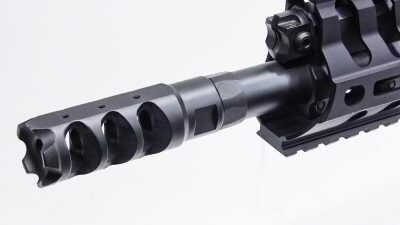
Topping the barrel off is the triple port muzzle brake. It features blunt strike prongs and includes a nitride heat-treated collar jam nut.
Greater Than the Sum of its Parts
POF has long been known for including unique design features in their guns and the Revolution is no different. First up is the inclusion of POF’s patented E-2 dual-extraction design. This design consists of four small channels cut into the walls of the chamber allowing a small amount of gas pressure to push against the neck of the spent case. This pressure assists in extraction by breaking the seal between the chamber and case as well as pushing the spent case to the rear as the extractor is pulling to the rear. This removes a tremendous amount of work that would otherwise be left up to the extractor. The end result is not only super reliable extraction, but the extension of the extractor life in your new rifle. The barrel used on the Revolution is POF’s popular 16.5-inch match-grade chrome alloy barrel. They are nitride heat-treated for full corrosion resistance and rifled in 1:10. Topping the barrel off is the easily recognizable triple port muzzle brake. The brake is designed to allow the shooter to have faster follow-up shots with soft felt recoil. It features blunt strike prongs and includes a nitride heat-treated collar jam nut.
The Revolution is a piston gun and as such includes POF’s adjustable gas system. The POF gas system allows the user to restrict, and even shut off, extra back pressure by simply rotating the gas plug. This is crucial when running suppressors which adds back pressure to a firearms operating system and thus increase bolt speed. This causes premature wear on the firearm and can even result in rounds stove piping during ejection.
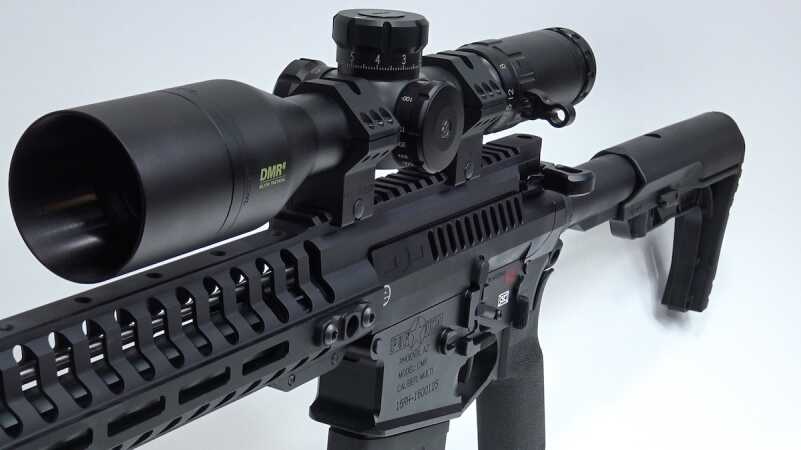
To get the best performance possible out of the Revolution, the author fitted it out with a Bushnell Elite Tactical DMR II 3.5-21x50mm scope.
Finishing out barrel-centric points is an oversized heat sink barrel nut. While rarely of interest to the average shooter, the significant design of this nut is worth talking about. When I asked Frank about the design he proudly shared the details. “At three inches long it completely encompasses the chamber and throat area of the barrel where expanding gas temperatures peak. Take into account the radiation properties of aluminum compared to traditional steel and you have 17 times more heat dissipation than a standard AR. Our barrel nut’s 3-inch length also gives the operating rod substantial guiding surface assuring constant positive contact with the bolt carrier. Our enhanced backbone receiver also moves the upper’s natural stress point forward. This adds a massive amount of rigidity to the overall platform and is critical when vertical fore grips are being pulled on the upper assembly.”
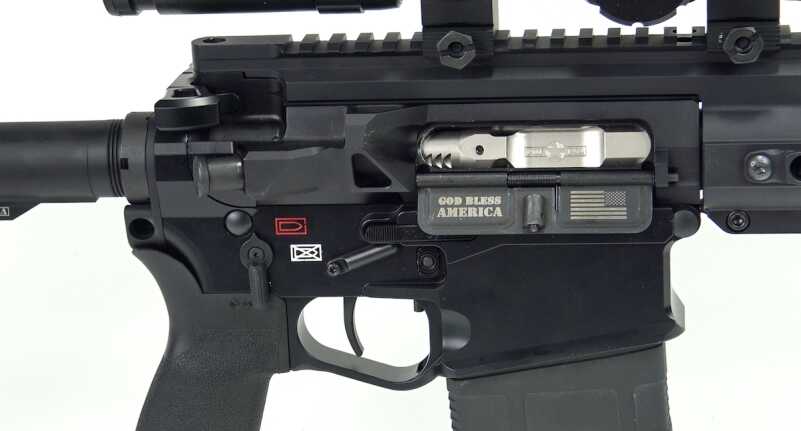
One of the cornerstones of the gun is POF’s use of their Gen 4 lower receiver. The lower is designed to improve ease of use and to make the gun as ambidextrous as possible.
Wrapping the barrel and gas system is their patented Modular Railed Receiver (M.R.R). This is a two piece upper assembly with a free-floating monolithic handguard that slides on and interfaces directly to the upper assembly thanks to our upper’s reinforced backbone. The super rigid design provides a good grip surface while allowing the barrel to remain free of contact.
The bolt carrier group used in the Revolution is essentially the same one used in their 5.56 guns with only slight modifications to manage the .308 round. It is a one-piece NP3 plated bolt carrier manufactured with the mechanical key built into the body and positioned behind the cam pin. The design helps reduce carrier tilt. The unit features a chrome-plated bolt extractor and firing pin which is both corrosion resistant and functionally smooth. There is one part of the BCG that needs a closer look. The patented roller cam pin used by POF is very nice. It was designed to reduce friction and drag in the action and they have succeeded. POF’s NP3 coated roller head actually rolls inside the channel of the upper thus eliminating friction and prolonging the life of the upper.
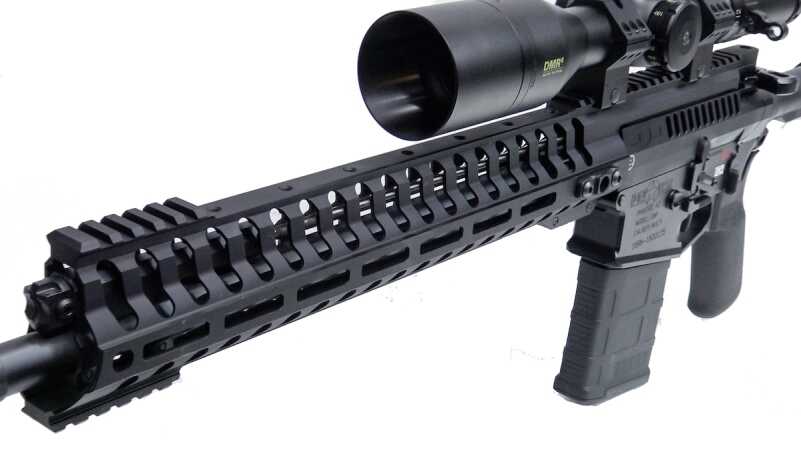
The fore end is the patented Modular Railed Receiver (M.R.R). This is a two piece upper assembly with a free-floating monolithic handguard.
One area that is often given just a passing thought is the buffer tube. This is not the case with the Revolution. The design includes a mil-spec aluminum anti-tilt tube that features “carrier cradle” extensions to ensure that the carrier is always supported by the buffer tube even when the bolt carrier is fully forward. This prevents carrier tilt and premature wear of the buffer tube. The buffer detent now doubles as a lock that inhibits the buffer tube from rotating and becoming loose under adverse conditions. If you shoot a lot, you know the frustration of a loose buffer tube. POF has solved that.
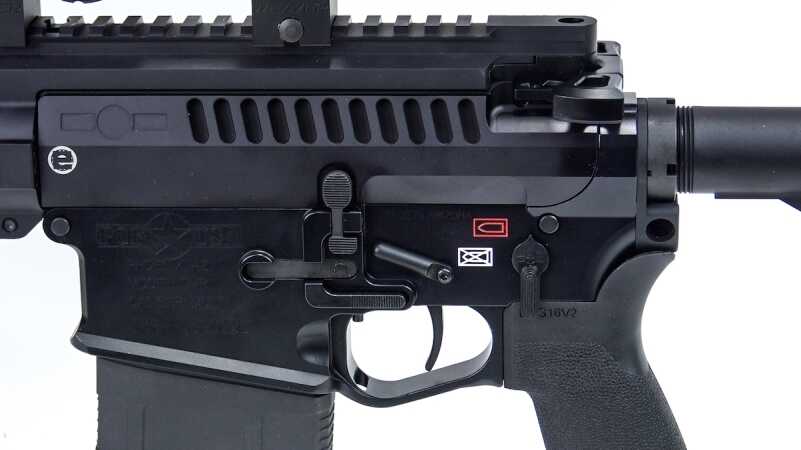
Note the petite size of the receiver behind the magazine well, in addition to the well-appointed controls.
Gen 4 Magic
One of the cornerstones of the gun is POF’s use of their Gen 4 lower receiver. The lower is designed to improve ease of use and to make the gun as ambidextrous as possible. Some of the specific features of the Gen 4 lower are:
- Ambidextrous bolt release with enhanced bolt catch
- Ambidextrous safety selector
- Receiver tension screws
- Oversized mag well flare
- Ambidextrous recessed finger rest
- Ambidextrous magazine release
- Oversized integrated trigger guard w/ grip relief
- Ambidextrous bolt hold open
- Available QD rear sling mount
Finishing the gun out is the trigger. Well known for their drop-in triggers, POF made sure to bring a winner to this gun. They include a single stage drop-in unit set at a good 4.5-pound pull. It has a great feel and includes custom-fit stainless steel KNS precision anti-walk pins.
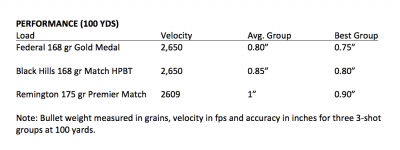 Walk the Walk
Walk the Walk
While all of this looks good on paper, it is my job to make sure the gun runs as advertised. With that, we packed up and headed to the range. While my first instinct with any rifle chambered in .308 is to look at its long-range capability, this rifle could easily be seen as an urban combat rifle as well. So, it would be a mixed day on the range with some bench work as well as dynamic applications. Shooting groups were the first order of business and group it did. To get the most out of the process I mounted a Bushnell Elite Tactical DMR II 3.5-21x50mm scope with their G3i illuminated reticle. It is an exceptional piece of glass and would serve me well on this rifle. The trigger broke cleanly and the rifle quickly punched nice small groups. POF promotes the rifle as being a MOA shooter and it kept its promise. In fact, I was able to get a group ¾ of an inch, which is great. The challenge of shooting groups with such a light rifle is its movement after fire. It took a moment to get back on target after a shot. The recoil, however, was still fairly light for such a lightweight gun and it was a smooth shooter. Once we moved into more dynamic applications such as shooting steel near/far, the gun really began to shine. Its light weight and small size made it fast. The gun is absolutely a fighter and performed well.
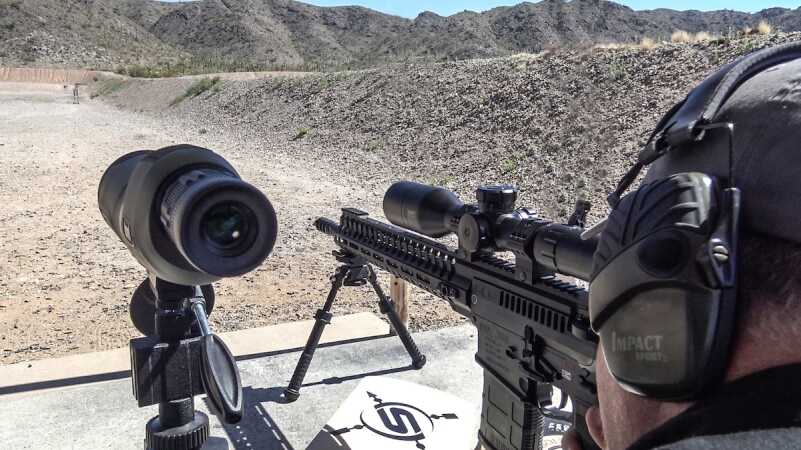
The Revolution performed well for the author, giving him a tightest group of 0.75 inches and sub-MOA best groups across the board.
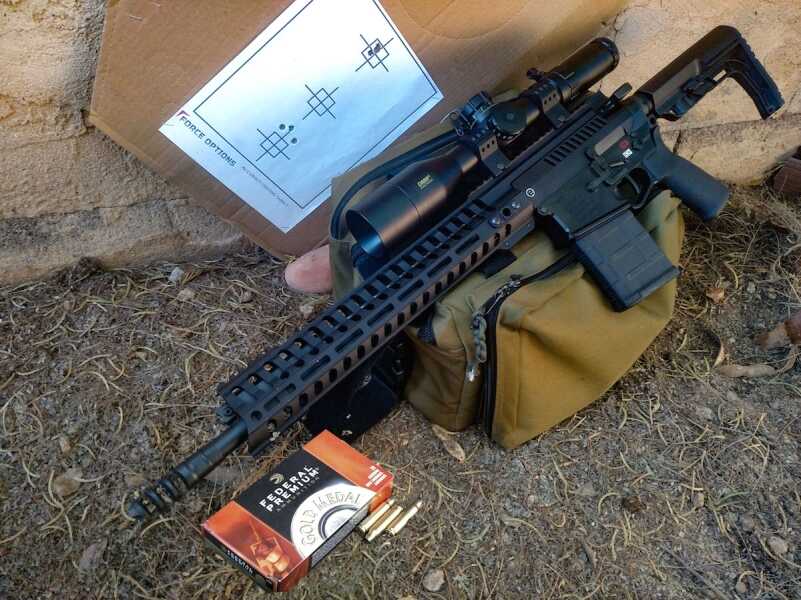
The Federal load performed the best out of the Revolution, although all loads tested did quite well.
Conclusion
My take away from time with this rifle is pretty clear. POF has succeeded in building a .308 rifle that is as small and light as its 5.56 brother. Mix in the unique features POF is known for and the gun moves into the serious business category. With more people focusing on rifles as personal defense weapons, I would have to inject this gun into the conversation. Considering that it is the same size as a standard AR-15 but packing .308 power, it is hard to deny that the Revolution has begun.
For more information, visit https://pof-usa.com/revolution/.
To purchase a POF-USA AR on GunsAmerica.com, click this link: https://www.gunsamerica.com/Search.htm?T=POF<id-all=1&as=730&cid=4&ns=0&numberperpage=50&.

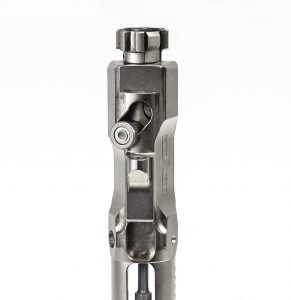
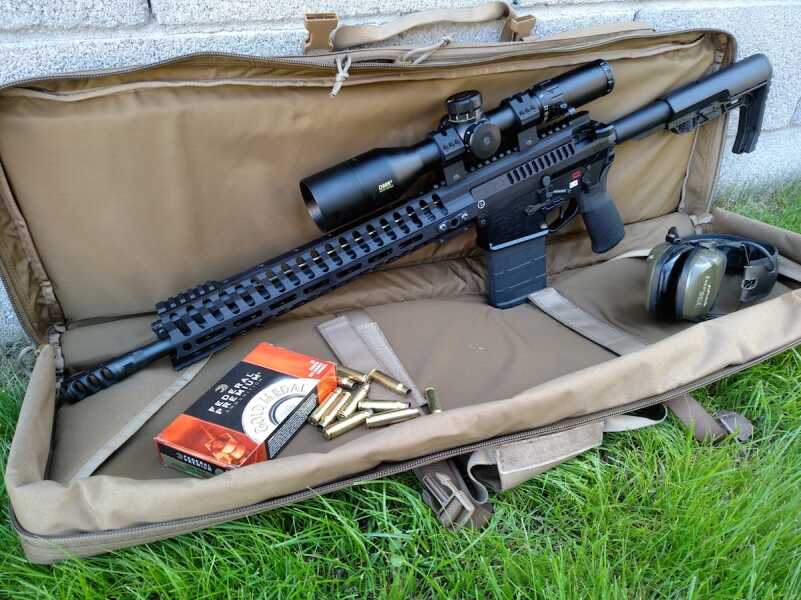
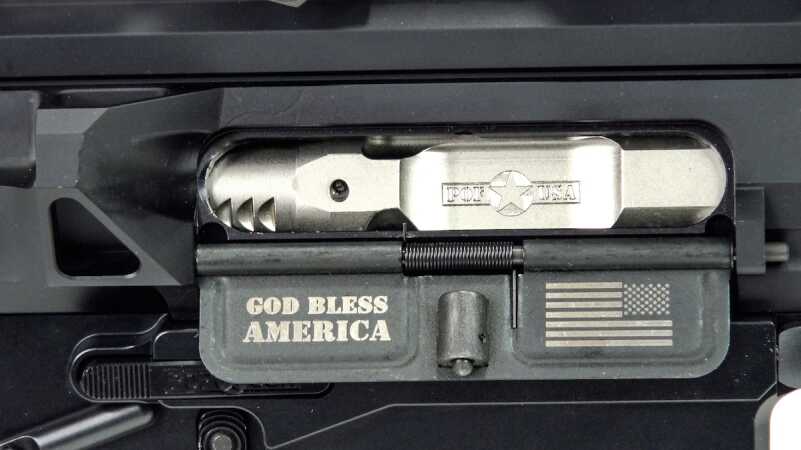
Great to see full review of A 5.56-Sized .308 AR.Thank you for sharing with us.Regards,
Rammy
DMA Inc.
Interesting article. I have a POF 415 but I’m thinking about grabbing a 308 down the road.
Also… to the author/editor; please stop using “centered around” it’s not correct.
Funny, it seems to me like all AR-10’s with the same barrel length as the comparable AR-15’s are “practically” the size of a 5.56mm AR-15.
Who gives a shit about the flag, it’s the first thing that is being removed when I get one.
IF you don’t Respect the FLAG then as an American I will NEVER respect you… Leave my Country Sir!
I’ll venture to say that most people that would buy a rifle probably care about the flag.
In Soviet Russia, flag remove you.
If you don’t give a shit about our flag, us patriots don’t give a shit about you traitor! Leave our nation or die!!!
Thank you for a well written article on POF’s Revolution .308. I read a recent review that stated this rifle was functional using only the provided 5 round 3rd gen P-Mag. Your groupings were great using the 20 round mags. My Sig MPX cleans up easily as this rifle does. Thanks to the reviewer who confirmed the easy clean nature of this weapon. And thanks to the veterans who cleared up the confusion on the direction of the flag decal.
I’d rather have a 300 BlackOut. I can just switch out the barrel and I can use my AR magazines and same BCG.
1) You do know we’re talking about a .308 WIN rifle here, right?
2) Have you ever shot a rifle before?
3) “New barrel, new bolt.”
WHAT IS THE PURPOSE OF THE BUFFER SPRING?I have heard two explanations for the buffer;1. It reduces recoil. When I was a young, I weighed 135lbs. I fired a .50 B.M.G. rifle with no muzzle break. It kicked like a mule! O.K. it kicked. I wouldn’t want to fire it all day. I have fired .300 and 308 magnums all my life — even as a little kid. If you can’t stand the recoil, get out from behind the butt plate!
2. An automatic or semi-automatic weapon will not cycle properly if it is held too rigidly. I saw an episode of “Red Jacket” where the boss welded an automatic weapon with no buffer directly to the roof of a pickup. All of his young gunsmiths said it would jam because there was no buffer. It didn’t jam. The recoil was absorbed by the springs of the truck. Every time I have fired a rifle or seen one fired the recoil pushed the shooters shoulder back a little. Wouldn’t this be enough to cycle the next round? Have we become a nation of snowflakes or are we so strong and solid that the recoil doesn’t push our shoulder back? I suspect the former!Can anyone help me?
The buffer spring returns the bolt into battery after firing a round and allows the bolt to obtain enough forward momentum to pick up the next round and allows the bullet and bolt to fully seat in the chamber. An AR style gun wouldn’t cycle without the buffer spring.
Wow, you are tough.
WHAT IS THE PURPOSE OF THE BUFFER SPRING?
I have heard two explanations for the buffer;
1. It reduces recoil. When I was a young, I weighed 135lbs. I fired a .50 B.M.G. rifle with no muzzle break. It kicked like a mule! O.K. it kicked. I wouldn’t want to fire it all day. I have fired .300 and 308 magnums all my life — even as a little kid. If you can’t stand the recoil, get out from behind the butt plate!
2. An automatic or semi-automatic weapon will not cycle properly if it is held too rigidly. I saw an episode of “Red Jacket” where the boss welded an automatic weapon with no buffer directly to the roof of a pickup. All of his young gunsmiths said it would jam because there was no buffer. It didn’t jam. The recoil was absorbed by the springs of the truck. Every time I have fired a rifle or seen one fired the recoil pushed the shooters shoulder back a little. Wouldn’t this be enough to cycle the next round? Have we become a nation of snowflakes or are we so strong and solid that the recoil doesn’t push our shoulder back? I suspect the former!
Can anyone help me?
Grim reaper 6. A buffer spring produces the opposing force that makes the second half of a “cycle” possible. Its purpose does not involve recoil, though some buffer systems can be modified to help lessen felt recoil. Was your big meaningless rant really necessary?
Heck, I think the weight alone is “news worthy.” Now, if they could just get the ammo weight down some 🙂
Yes this is a short 308 but thats the most fun if you ask me. i love my short cetmes pistols i made and the short hk51 copy i have. the boom is great and a common gun like the ar makes it easy to work on. this is a good hog gun or truck gun when traveling or fishing in dangerous terrain like we have here by the border. I like it and the fact its a real piston powered rifle instead of the tradition ar system makes it a great sidekick to my 308 saigas. id like to pick one up used in a year or two.
When the muzzle is pointed at the enemy, the flag is correct IMHO.
The blue field of the flag always faces forward (or the direction we are advancing). If it faced the other way, it would show us as retreating, which we don’t do.
Did not DPMS make a Gen II Recon Model .308/7.62 NATO with upper and lower same size as a 5.55 AR ? Granted it is not piston driven and no adj gas block , but used you can get one for $900-950. Once you put on your scope of choice and bipod , it won’t weigh 7 pounds anymore . Though I suppose if you want a .308 AR in place of a M-14 SOCOM style …. /shrugs . Lots of little touches make it a well put together rifle system .
But for that price , they should throw in 4-5 extra mags . IMO
I’m pretty sure the DPMS GII Recon is a AR-10 variant that has had weight taken off to make it lighter. In a review that I read on the DPMS GII Recon, the author takes the time to actually point out that the AR15 platform is different than the 308 platform, due to the fact that the GII Recon is a impressive weight shredded AR-10. The rifle still weighs in at 8.5lbs, which compared to the Revolutions 7.3 lbs, would make a noticeable difference due to weight distribution. What makes the Revolution a cool gun, is they are making a 308 AR Platform weapon system that has the ergonomics to compete with its 5.56 Nato cousin, while sustaining the punch you get with a 308. Despite the price, I will most likely get one of these, due to the fact that my state likes to ban many 5.56 AR15, but not the 308 variants, and I would very much like a weapon system with the ergonomics and overall handling of a AR15.
A 16″ barreled .308 seems like a waste. There are other .30 caliber options designed to function in short barrels at intermediate ranges with standard 30 round magazines and they sell for 40% of the cost.
If I can make good groups at 650yds using my 155gr AMAX handloads out of my 16″ lr308 then it’s definitely not a waste. Hell I shoot 130gr TTSX handloads out of my 12.5″ 308 suppressed at 2700 fps as my hunting setup. It shoots MOA at 400 yds too. I don’t understand why people still think 16″ is “short”.
What about an AR 15300?
I assume you are referring to 300BLK. It’s a good cartridge in its own way. It is meant for barrels that are actually short like 8″-10″. Shooting it out of a 16″ is a waste and wouldn’t gain any significant velocity than from a 10″. I know because I’ve tested it. And the best you can expect is about 2350 fps shooting a 110gr bullet, or 2250 with a 125gr bullet. Heavier than that and the velocity starts really dropping and bullets fail to expand.
Well, it’s a nice piece of work for anyone who never met an AR they didn’t like, but since the point emphasis of the article was its compact and light weight presentation, most serious shooters I know who like a compact lightweight AR platform that reaches out a little further with a little more ‘authority’ than a 5.56 and for all practical purposes performs about the same as a .308 opt for the 6.5 Grendel. An moa 6.5 Grendel AR-15 can be put together for less than half of what this costs, With similar whistles and bells, but will weigh a pound less and you can carry more ammo because the round is lighter also.
The problem with 6.5 Grendel is that you need a 24″ or longer barrel to reach the same velocities as a 308 out of a 16″ barrel if you’re using bullets that are a weight worth using. It’s a very overrated cartridge.
Wasn’t the idea of a piston design to eliminate gas fouling of the chamber and bolt area?????
So, what’s the long term use without frequent cleaning going to show?
I realize it’s a minimal amount of gas, just curious.
I’m an Army vet and I own a POF P308, so I am familiar with typical fouling in both the direct-impingement and the gas piston platforms. I say “fouling in both”, but I mean only “fouling in a direct-impingement platform” – the P308 pretty much doesn’t foul. After a shooting session with the P308, I take it apart and wipe the slightly contaminated lubricant off the bolt and carrier, and that’s about it. No scrubbing or picking, or special solvents needed, no baked-on carbon. It’s that clean.
Thanx! Good to know.
Piston guns still have fouling, it’s just in the piston instead of the bolt carrier.
Im pretty sure FGMM is much lower and I can guarantee M118lr is going to be right around 2500 fps. AB39/Mk316 may get you closer to the 2600 but it’ll have be be shot in a DA around 10,000
Did anyone else notice that the flag on the dust cover is backwards. The stars should be in the upper left from the observer’s point of view. I hope Patriot fixes this before full production.
The military/LEO community wears the flag patches on their uniforms with the flag being blown back as if charging towards the enemy. Thus the flag on the dust cover is correct.
WHAT?! That flag pattern if for the left shoulder. It is NOT correct for a right-side port cover. Unless the rifle bearer is running backwards! That’s why this pattern is called “reverse flag”.
No, we wear the flag on our right shoulder. The flag on the dust cover is correct. POF has lots of vets working for them, they did it right.
The flag is always worn so that the field leads, as Jim explained. So the location of the field on a patch determines which shoulder it’s meant to be worn on. If the field is on the right, it’s meant for the right side, and vice versa.
Sad for a company that promotes patriotism to miss this point! Like you, sadly, this was the first thing I noticed also. Backwards patriotism?
For all you know it alls, obviously non-military folk, the stars always face the enemy. The company got it right. You got it wrong! Amateurs!
Shawn,
When the American flag is displayed as an image on a mobile item such as a vehicle, or in this case firearm, it is customary to orient the image such that, from the viewer’s perspective, flag is displayed as if moving “into the wind,” (i.e. – halyard side as the leading edge). Therefore, on the right side of the weapon, or a vehicle, the flag is properly displayed with the halyard side facing forward, just as the folks at POF have it.
So if the observer is standing on the opposite side of the flag pole or is standing on the exact same side of the flag pole but the wind happens to entirely reverse direction, their specific view of the flag is now somehow disrespectful to our flag? That’s doesn’t make any sense to me… Old glory is the same flag regardless of whether she is blowing to the right of the left of the side of the flagpole that I happen to be facing.
The American flag appears in this exact same position from the exact same perspective on the dust cover of my POF P308 and every other rifle they make. This is the first time I have ever heard anyone share this same pretty-stupid opinion of yours about the obviously patriotic artwork this great little company has selected for their rifle’s dust covers… I guess some people just like to complain even when there is nothing to complain about.
No, they’re not. Do more research on why the flag is in that position…
So this is one of those things that came out of military circles… stars forward,
Here is an explanation from CollinsFlags.com (google result)
Civilians often wonder why the American Flag on military uniforms are worn ‘backwards.’ Some speculate that it represents the U.S. military is always moving forwards, others speculate it symbolizes the flag always points home.
However, according to Army regulation 670-1, Wear and Appearance of Army Uniforms and Insignia, the regulation states when authorized for application to the proper uniform, the U.S. flag patch is to be worn, right or left shoulder, so that “the star field faces forward, or to the flag’s own right. When worn in this manner, the flag is facing to the observer’s right, and gives the effect of the flag flying in the breeze as the wearer moves forward. The appropriate replica for the right shoulder sleeve is identified as the ‘reverse side flag’.”
You do know that many of the patches of our Flag worn on the right arm are like that???
The idea is, the Flag is moving FORWARD, not in retreat.
And which way is the gun pointing?
It’s the same on a vehicle, if the Flag is on the right Door or front fender, it is reversed.
The flag is on correctly because America always moves forward not backwards.
You are looking at the ejection port for a right handed rifle. The flag is correct.
No, I believe the intent was the same as the wearing of the flag on the uniform. If the flag is on your right shoulder, it’s reversed, just like the dust cover on the right side of the firearm. The flag should always look like you’re facing into the wind, so reversed on the right shoulder, standard on the left.
I think some readers are confused by the term “reversed flag.” It doesn’t mean the flag is being flown improperly, it means it’s meant to be viewed from the other side. The standard flag (with the field on the left) is meant for the left side or shoulder, while the “reverse” flag is meant for the right (i.e., “reverse”) side. It’s not really the flag that’s “reversed,” it’s the viewer’s perspective.
It is facing that direction for the same reason that the flag on the right shoulder on the Marine Corp uniform faces that direction.
Marines don’t wear flag patches… you’re probably thinking of the Army.
I don’t think you are getting 2650 FPS from FGMM in a 16″. 2650 FPS is what Federal publishes as the velocity of the load from a 24″ barrel.
I’ve got the P308 and the P415 and can attest to the author’s claim of reliability and accuracy. Throw a 25rd Pmag in the Revolution and you’re almost at AR15 capacity, but with far more “oomph”
I like everything except the price of purse. However with any non milspec or new design hues I like to set back and see how it wears in real life use and ofcourse combat which we may not get with this rifle, but if it turns out to be at least as dependable as a milspec AR15 or more then what’s not to love? Oh yeah the heavier cost and reduced 20 ct mag of the .308 but that’s still something I could overlook if it can deliver such power dependably. Kudos to POF’s creativity and Patriotism too!
https://pof-usa.com/wp-content/uploads/2015/08/AfterActionReport_addendum12-14.pdf
The subject rifle has a hybrid operating system as such combinations of gas piston and buffer have been categorized for years. That buffer cost them a folding stock while firing option. Ther gas piston Russian SVD (7.62X54R) has a folding stock option. I understand POF wanted this rifle to be like a AR 15 in size but Ruger had the same hybrid system years ago in the SR762. The Ruger is 3/4 inch longer and 13oz heavier but I don’t think they were trying to make it AR15 size. I’m not saying either rifle is better then the other, just tossing out a few specs.
I don’t know where you get that. An operating system is named according to how it extracts energy from the firing of a round in order to “operate” a firearm. Any operating system that uses gas bled out of the barrel is a “gas operating system.” Those that use the gas to move the action directly are “direct impingement” and those that use an intermediate rod or piston are gas rod or piston systems. AFAIK, all gas operated firearms use springs to return the operating system into battery, and whether they use a buffer tube or not has nothing to do with the name of the type of system. A piston system can use a buffer tube (most ARs and POF) or recoil springs on an operating rod (or rods) (SIG MCX) that permits the use of a folding stock. This does not make one or the other a “hybrid” system because the operating system name has nothing to do with the elements of the system that return a gun to battery.